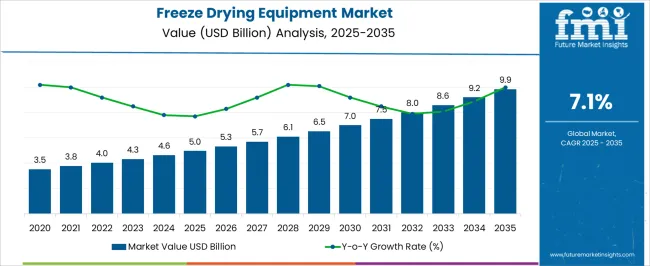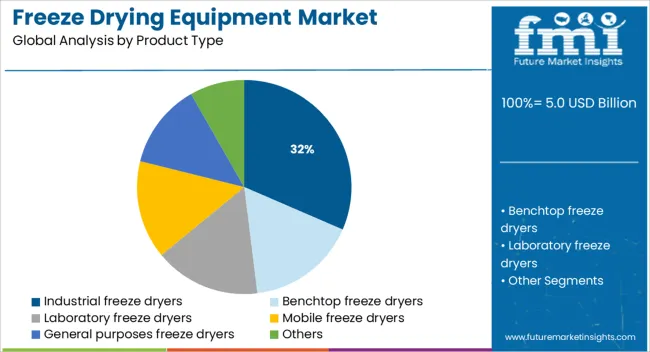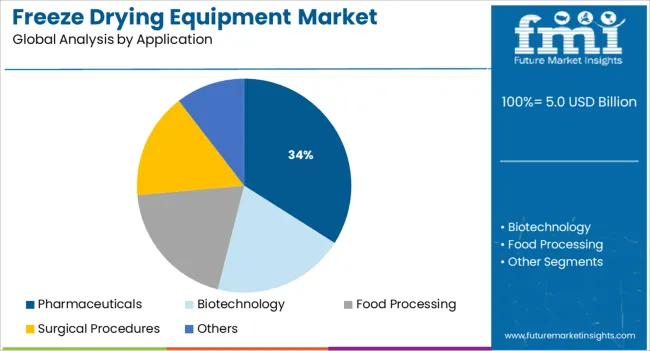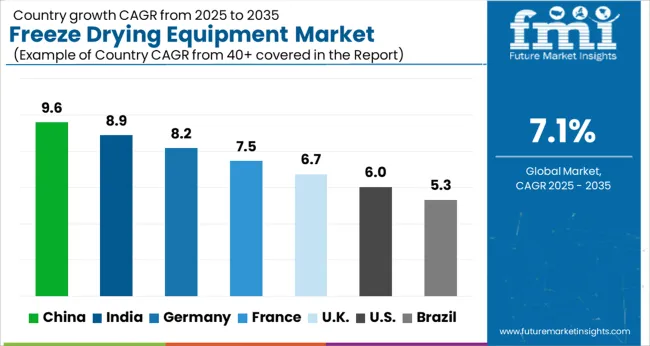The Freeze Drying Equipment Market is estimated to be valued at USD 5.0 billion in 2025 and is projected to reach USD 9.9 billion by 2035, registering a compound annual growth rate (CAGR) of 7.1% over the forecast period.

| Metric | Value |
|---|---|
| Freeze Drying Equipment Market Estimated Value in (2025 E) | USD 5.0 billion |
| Freeze Drying Equipment Market Forecast Value in (2035 F) | USD 9.9 billion |
| Forecast CAGR (2025 to 2035) | 7.1% |
The freeze drying equipment market is experiencing sustained growth due to the increasing need for high-performance preservation technologies in pharmaceuticals, biotechnology, and industrial food processing. Demand for freeze drying systems is being shaped by the ability of these technologies to extend product shelf life, maintain structural integrity, and ensure sterility in sensitive applications. Innovations in vacuum-based dehydration systems, coupled with advancements in thermal control and process automation, are reinforcing adoption across commercial-scale operations.
Growing regulatory emphasis on product quality, cleanroom integration, and batch traceability is further influencing the equipment choices in pharmaceutical and biotechnology sectors. Additionally, the rising global burden of chronic diseases has increased the need for stable biologic formulations and injectable therapeutics, both of which benefit from freeze drying.
Industrial segments are also witnessing increased adoption of large-scale systems for preserving active ingredients and temperature-sensitive compounds As global supply chains expand and cold chain infrastructure advances, the freeze drying equipment market is expected to witness accelerated installations, particularly in high-throughput and precision-controlled environments.
The market is segmented by Product Type and Application and region. By Product Type, the market is divided into Industrial freeze dryers, Benchtop freeze dryers, Laboratory freeze dryers, Mobile freeze dryers, General purposes freeze dryers, and Others. In terms of Application, the market is classified into Pharmaceuticals, Biotechnology, Food Processing, Surgical Procedures, and Others. Regionally, the market is classified into North America, Latin America, Western Europe, Eastern Europe, Balkan & Baltic Countries, Russia & Belarus, Central Asia, East Asia, South Asia & Pacific, and the Middle East & Africa.

Industrial freeze dryers are expected to account for 31.5% of the total revenue share in the freeze drying equipment market in 2025, making it the leading product segment. This growth has been primarily driven by the increasing demand for large-scale, continuous processing capabilities in pharmaceutical manufacturing, nutraceuticals, and specialty chemical sectors. The ability of industrial freeze dryers to handle high-capacity batch sizes with consistent temperature and pressure regulation has reinforced their adoption in commercial production environments.
Integration with programmable logic controllers and remote monitoring systems has enabled enhanced process control, allowing real-time optimization and compliance with quality standards. Furthermore, improved chamber designs and energy-efficient configurations have made these systems suitable for long-duration cycles while minimizing operational costs.
The segment's prominence is also supported by the expansion of biopharmaceutical manufacturing facilities and contract manufacturing organizations, where scale and throughput are critical The shift toward automated, GMP-compliant equipment in global production hubs continues to support the dominant position of industrial freeze dryers in the overall market.

The pharmaceuticals segment is projected to contribute 34.0% of the revenue share in the freeze drying equipment market in 2025, reflecting its central role in driving technological adoption. This segment's dominance has been supported by the rising global production of vaccines, biologics, and injectable drugs that require moisture-sensitive stabilization for safe storage and transport. The freeze drying process has become a critical step in ensuring product integrity and shelf-life extension for parenteral formulations.
The increasing development of personalized medicines and biopharmaceuticals has further emphasized the need for precision-controlled lyophilization processes. Regulatory requirements around aseptic processing, particulate contamination, and product sterility have accelerated the deployment of advanced freeze drying systems within pharmaceutical manufacturing units.
Demand has also been elevated by the expansion of fill-finish facilities and the need to preserve high-value therapeutics across varied climatic zones As industry players continue to invest in next-generation formulation and drug delivery systems, freeze drying equipment is expected to remain a foundational asset in pharmaceutical production workflows.
During the historical period from 2020 to 2025, the global freeze-drying equipment market exhibited steady growth at a CAGR of 5.4%. The market is projected to grow at a considerable pace in the next ten years on the back of the rising usage of freeze-dried food products by military personnel and astronauts. Growth is mainly attributed to the difficulty of carrying conventional dry food items.
High temperatures used can lead to physical or chemical changes in food items, for instance. Their overall quality will also not remain on par with freeze-dried food products. In May 2024, for instance, Sow Good Inc., a food products start-up based in Irving, introduced Sow Good, its new direct-to-consumer (DTC) freeze-dried consumer packaged goods (CPG) food brand.
The company uses state-of-the-art freeze-drying technology to eliminate water from fruits and vegetables. Thus, similar cutting-edge technology developments by key companies and start-up firms worldwide are expected to boost the global freeze-drying equipment market to 7.1% in the forecast period.

Need for Products with Long Shelf Life to Spur Sales of Food Freeze Dryer Machines in the USA
The freeze-drying equipment market in the USA is estimated to be worth about USD 1,060.2 million and holds nearly 68% of the share in North America during the evaluation period, says FMI. Increasing demand for on-the-go snacks is likely to push manufacturers to distribute their frozen food items across the USA
Also, the rapid expansion of the food processing and pharmaceutical industries in the country is projected to aid growth in the freeze-drying equipment market. As freeze-drying equipment helps in extending the shelf life of frozen food items, these products are set to gain high popularity in the USA
Rising Sanitation Standards in the UK to Foster Sales of Commercial Freeze Dryers
In the next ten years, it is expected that the UK will create an absolute dollar opportunity of USD 366.8 Million. As per FMI, the country is likely to generate nearly 22% of the share in the Europe freeze-drying equipment market by the end of 2035.
The market in the UK is anticipated to grow steadily as demand for freeze-drying equipment is increasing with rapid urbanization and the booming food industry. Household consumption is also one of the major factors responsible for driving the freeze-drying equipment market in the country. Furthermore, advancements in the freeze-drying equipment sector such as merging all process equipment into one to save human labor and increasing sanitation standards, are projected to propel the market.
Surging Snack Consumption in China to Push the Demand for Food Drying Equipment
According to FMI, the China freeze-drying equipment market is set to be worth over USD 304.9 Million, accounting for 32% of the Asia Pacific market in the forecast period. This growth is attributed to the rising population with a wide range of socioeconomic and cultural characteristics.
Furthermore, as western countries have increased their investments in the country to expand the food industry, demand for freeze-drying equipment has also surged. It has also led to the advancement of production levels and a reduction of the overall processing time.
In addition, market expansion has been aided by rapid population growth and increasing awareness about the availability of high-quality biological products. The presence of numerous renowned producers, particularly in China is another vital factor that would bode well for the market. Furthermore, due to rising snack consumption in urban areas and the increased need for processed food products, the China freeze-drying equipment market is expected to develop at a fast pace.
Food Processing Industry to Extensively Utilize Lyophilization Equipment by 2035
Based on application, the food processing segment is set to remain at the forefront in the global freeze drying equipment market during the evaluation period. Lyophilization is extensively used as a preservation technique in the food processing industry as it retains the flavor and nutritional value of various food items. Many food ingredients are also expected to be freeze-dried to extend their shelf life, which is further projected to drive the use of this technology in the food processing industry.

The global freeze-drying equipment market is highly fragmented with the presence of a large number of small- and large-scale companies. They are mainly focusing on mergers and acquisitions with local players to co-develop innovative products and distribute them across the globe. Meanwhile, a few other key companies are engaging in collaborations with international firms and start-ups to develop new production facilities in untapped areas.
For instance,
| Attribute | Details | |
|---|---|---|
| Estimated Market Size (2025) | USD 5.0 billion | |
| Projected Market Valuation (2035) |
|
|
| Value-based CAGR (2025 to 2035) | 7.1% | |
| Forecast Period | 2025 to 2035 | |
| Historical Data Available for | 2020 to 2025 | |
| Market Analysis | Value (USD Million) | |
| Key Regions Covered |
North America; Latin America; Europe; Asia Pacific; Oceania; Middle East & Africa (MEA) |
|
| Key Countries Covered |
The USA, Canada, Mexico, Germany, The UK, France, Italy, Spain, China, Japan, India, South Korea, Australia, Brazil, Argentina, South Africa, UAE |
|
| Key Segments Covered |
Product TypeType, Application, Region |
|
| Key Companies Profiled |
GEA Group Aktiengesellschaft; Azbil Corporation; Tofflon; Industria Macchine Automatiche S.p.A.; SP Industries, Inc.; HOF Sonderanlagenbau Group; Labconco; Martin Christ Gefriertrocknungsanlagen GmbH; Millrock Technology, Inc.; OPTIMA Packaging Group GmbH; BÜCHI Labortechnik AG; Scala Scientific; Zirbus Technology GmbH; Biopharma Process Systems Ltd.; MechaTech Systems Ltd.; Cuddon Freeze Dry; Freezedry Specialties, Inc.; Cryotec; Freeze Drying Systems Pvt. Ltd; Lyophilization Systems India Pvt. Ltd. |
|
| Report Coverage | Market Forecast, Company Share Analysis, Competitive Landscape, DROT Analysis, Market Dynamics and Challenges, and Strategic Growth Initiatives |
The global freeze drying equipment market is estimated to be valued at USD 5.0 billion in 2025.
The market size for the freeze drying equipment market is projected to reach USD 9.9 billion by 2035.
The freeze drying equipment market is expected to grow at a 7.1% CAGR between 2025 and 2035.
The key product types in freeze drying equipment market are industrial freeze dryers, benchtop freeze dryers, laboratory freeze dryers, mobile freeze dryers, general purposes freeze dryers and others.
In terms of application, pharmaceuticals segment to command 34.0% share in the freeze drying equipment market in 2025.






Full Research Suite comprises of:
Market outlook & trends analysis
Interviews & case studies
Strategic recommendations
Vendor profiles & capabilities analysis
5-year forecasts
8 regions and 60+ country-level data splits
Market segment data splits
12 months of continuous data updates
DELIVERED AS:
PDF EXCEL ONLINE
Freezer Label Market Size and Share Forecast Outlook 2025 to 2035
Freezer Liner Market Size and Share Forecast Outlook 2025 to 2035
Freeze Neutralising Kit Market Size and Share Forecast Outlook 2025 to 2035
Freeze Dried Fruit Powder Market Size and Share Forecast Outlook 2025 to 2035
Freeze-dried Food Market Analysis - Size, Growth, and Forecast 2025 to 2035
Freeze Dried Fruits Market Analysis - Size, Share, and Forecast Outlook 2025 to 2035
Freezer Paper Market Size and Share Forecast Outlook 2025 to 2035
Freeze Dried Fruits And Vegetables Market Size and Share Forecast Outlook 2025 to 2035
Freeze-Dried Vegetables Market Analysis - Size, Share, and Forecast Outlook 2025 to 2035
Freeze-Dried Pet Food Market Anlysis by Pet Type, Nature, Source, Process Type, and Sales Channel Through 2035
Freeze Dried Melt Market Analysis by Product Form, Fruit Type, Sales Channel, Packaging, , and Region Through 2035
Freezer Bags Market Growth, Trends and Demand from 2025 to 2035
Competitive Overview of Freeze Dried Fruits Market Share
Competitive Breakdown of Freezer Paper Manufacturers
Freezer Tape Market
Freeze Drying Market - Size, Share, and Forecast Outlook 2025 to 2035
UK Freeze Dried Fruits Market Insights – Size, Demand & Industry Growth 2025–2035
Antifreeze proteins Market Size and Share Forecast Outlook 2025 to 2035
Antifreeze Market Size and Share Forecast Outlook 2025 to 2035
USA Freeze Dried Fruits Market Growth – Innovations, Trends & Forecast 2025–2035

Thank you!
You will receive an email from our Business Development Manager. Please be sure to check your SPAM/JUNK folder too.
Chat With
MaRIA